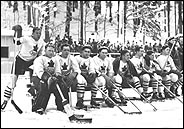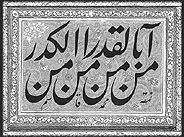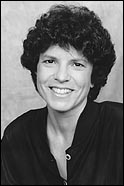on campus
Of course: Beading a retreat
 ILLUSTRATION: TZIGANE
ILLUSTRATION: TZIGANE
| |
When it comes to activities that relax, yoga, tai chi or meditation come to mind. But beading?
Yet when asked why the First People's House is offering a course in the ancient art — free of charge to any McGill person — the first response is: "It's a way to force you to relax."
"Beading takes your mind off everything else; it's very rhythmic," says Tracee Diabo, coordinator of the First Peoples' House. She first programmed the course last winter as a means of bringing native students into her Peel Street centre. This time around, she wants everyone to have the opportunity to learn the craft, work with others, learn about Mohawk culture and, perhaps, discover some previously unknown creativity.
Diabo learned to bead as a child on the Kahnawake reserve, but found it frustrating. She discovered a new love of the craft only as an adult. "I started with simple stringing, then wanted to learn more and more. It's part of whom I am, of who we are.
"Beaded work was used for trade, gifts, adornments and in ceremonies," she says, noting the wampum belts recently on display at the McCord Museum's exhibit on beading, that were used to mark understandings between people.
This semester, Valerie Braithwaite, also a Mohawk, will be teaching the two-hour course. "Bracelets, earrings, necklaces, loomwork ... I'll help them with whatever they want to do," she says. Her favourite beaded creation is her bingo dauber, used to mark game cards. "Though there's no evidence yet that it brings me good luck," she chuckles.
Those interested in the course may attend, beginning today at noon at First People's House, 3505 Peel Street, or reach Tracee Diabo at 398-3217 or tdiabo@po-box.mcgill.ca. Bring your own beads, nylon thread and needles, all available at either the Bead Emporium in Westmount or at Dressmaker's on St. Catherine W.
Julie lands for a visit
 Julie Payette
Julie Payette
| |
Astronaut Julie Payette, fresh from being named to Maclean's annual honour roll of accomplished Canadians, will be speaking at Moyse Hall next Monday. Payette, who earned a bachelor's degree in engineering at McGill and did doctoral work at the Centre for Intelligent Machines (CIM), will be discussing the international effort to build an orbiting space station. She will also be presenting the CIM with a flag displaying the centre's crest that she took with her last May aboard the space shuttle Discovery.
There will be a brief Q and A period after Payette's presentation, which begins at 3:30 pm. All are welcome to attend.
Payette was invited to visit her alma mater by Dean of Engineering John Gruzleski.
Canadian Olympic Collection Up and Running
 Canadians took the gold at the Garmisch-Partenkirchen Winter Games, 1936
Canadians took the gold at the Garmisch-Partenkirchen Winter Games, 1936
| |
Put on your sneakers, for there's a 60-metre dash involved — that is, if the history, politics, economics, culture, etc., of international sport is your event. Now accessible from the McGill homepage, the Canadian Olympic Collection, physically housed in the Rare Books and Special Collections Division of McLennan Library, measures 60 linear metres and holds 4,500 items, written in 20 languages, including books, pamphlets, advertising, reports from the International Olympic Committee and one plastic model of the Olympic Stadium.
For Raynald Lepage, curator of the collection, who spent the past two years organizing the material, one of the most dramatic finds was the records from the Berlin Olympics, 1936. "It is the first time a country made a great effort to have good photographs," he says, noting in particular the work of Third Reich photographer Leni Riefenstahl, one of whose books is in the collection. "The games were used for propaganda to Germany's own people and to the world." The collection also has Hitler's speeches at the games.
The material is organized according to type of games: Olympic, Pan- American, Commonwealth, etc., and by type of document: books, International Olympic Committee Reports, etc. While only basic searches are possible on-line, that will change with time. Such an "unruly" collection of documents and three-dimensional objects makes developing "advanced search" on-line capacity "a work of years," says Irena Murray, chief curator of Rare Books. Nevertheless, with the name of an athlete, city or event, a considerable number of titles appear on screen.
On-site consultation, on the other hand, is available to the public, as was the hope of Dick Pound, vice-president of the IOC and chancellor of the University, when he suggested two years ago that the collection be given to McGill when Olympic House, Montreal, closed its Information and Resource Centre. It is perhaps the only public resource of its kind, notes Murray. While the collection is largely Canadian, it boasts 80 per cent of all the Olympic reports and documents for the period 1964-1996.
Murray notes that this "rich but bibliographically volatile" collection has attracted contributions from individuals, including the official athletes' souvenir album of Frank Shaughnessy — who competed for the U.S. in that city's Olympics — a gift from his niece Honora Shaughnessy, McGill's executive director of alumni relations.
Ancient treasures in a modern medium

| |
The Islamic masters of book-making who painstakingly etched the calligraphs, painted the miniature illustrations and decorated bindings would never have dreamed that one day their works, in the collection housed in Rare Books, would be visible to thousands the world over.
Or would they?
"He who believes in predestination is secure against anxiety," reads one example of calligraphy reproduced on the trilingual (Arabic, French and English all in one) CD-ROM, titled Treasures of Islam, soon to be launched by the Graduate School of Library and Information Studies.
Predestiny, or at least destiny, for these beautiful and rare books was shaped by the head of GSLI, Jamshid Beheshti, and CN-Pratt-Grinstand Professor of Information Studies Andrew Large when they submitted a proposal to CIDA to make a CD-ROM on McGill's important collection of antique Islamic manuscripts. Doctoral student Haidar Monkdad was project researcher.
Collected by the University since the late 19th century, the Islamic collection is considered to be one of the most important in Canada, says Beheshti, thanks, in part, to the presence of the Institute of Islamic Studies which began in the early '50s. While some of the documents may be consulted in rare books, many are too fragile to be handled.
While the CD-ROM sells for $65 and is intended largely for such institutions as libraries, galleries and museums, Beheshti has been pleasantly surprised by the interest expressed by individuals.
"We hope it generates enough interest for us to start a second type on another collection," says Beheshti, who describes the CD-ROM as being like an annotated catalogue with music. The latter was composed especially for the project by a Montreal musician and played on the ud, one of the oldest instruments in the world.
Aside from publicizing the treasures through the usual academic channels, McGill Services Inc., which is managing the marketing of the product, has secured space in the McGill Bookstore, at Chapter's on-line and is negotiating for an on-line spot with Amazon.com.
Wachtel on writers

| |
Given the context of her talk, it is fitting that when Eleanor Wachtel was a student at McGill in the 1960s, she had but one female professor during her entire four years as an honours English student.
"The most influential teacher I had was Ruth Wisse," said Wachtel, speaking over the phone from her office at CBC in Toronto. "She had such a passion for literature. She brought such animation to the discussion of books.
"I took her course on Yiddish writing in translation. It was an elective. All the required courses were taught by men."
Host of the radio programs "Writers & Company" and "The Arts Today," Wachtel speaks this evening in the second of a series of lectures celebrating the centenary of Royal Victoria College and a century of women's education in Canada.
Indicative of how times have changed since Wachtel's days at McGill, nearly 40 per cent of today's English department is comprised of women.
Wachtel will be speaking tonight about "the intersection between the life and the work" of such authors as Isabel Allende, Alice Munro, Jamaica Kincaid and Oliver Sacks.
"I'm interested in what fuels their art, informs their lives," she says.
Eleanor Wachtel speaks this evening at 6:00 pm in the lecture hall of the Macdonald-Harrington Building.

